A simple, easy, and delicious soaked whole wheat bread recipe that can be incorporated into any busy person’s routine to get the most nutrition out of bread. Be sure to try my overnight Artisan bread or my homemade French bread.
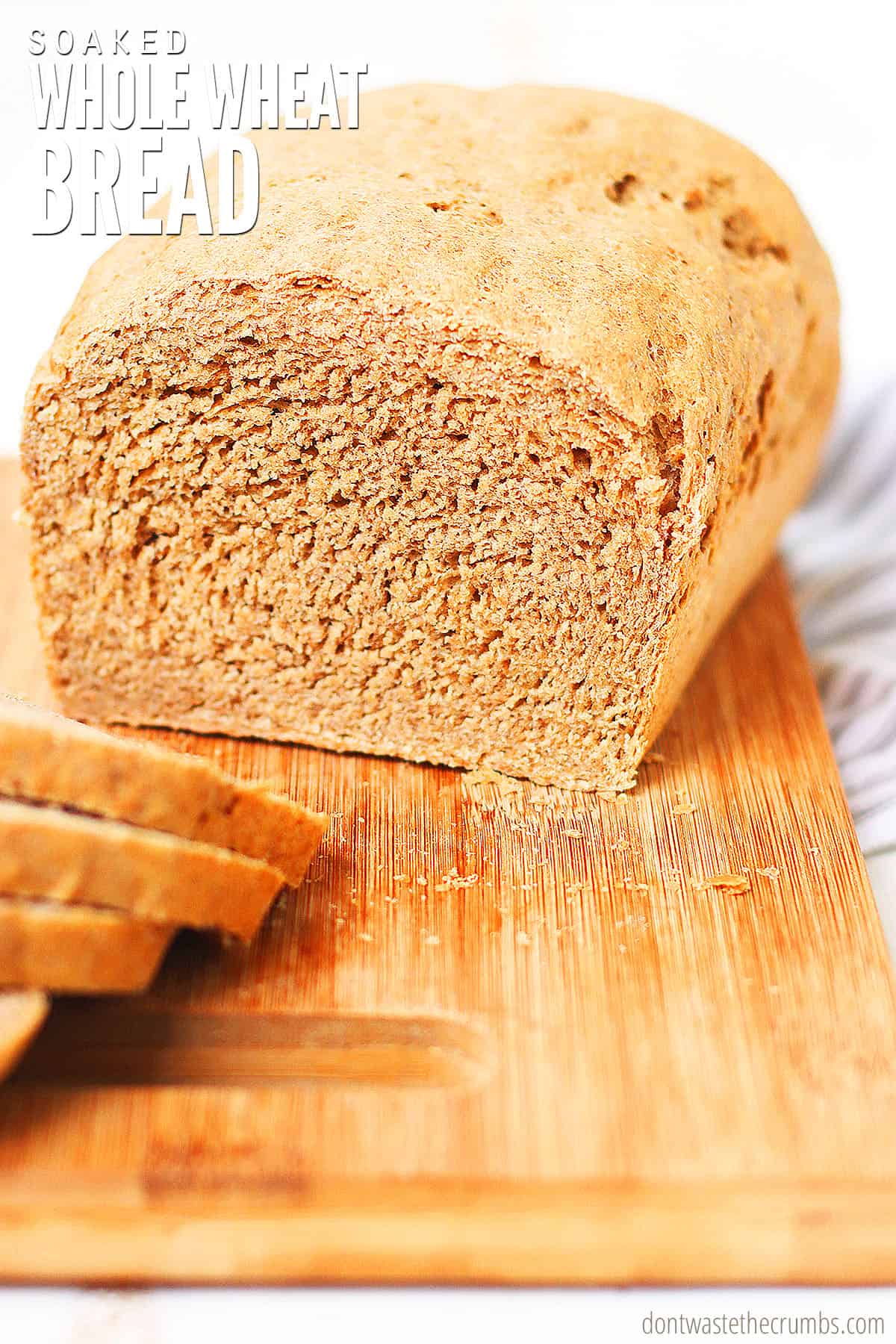
We talked about bread and carbohydrates, in general, a lot in the past. And I mean, a lot.
From bleached flour to unhealthy wheat bread to the healthiest bread you can possibly make, we covered just about everything there was to talk about when it came to preparing, eating, and enjoying carbohydrates in the healthiest way possible.
I’ll admit though – learning about real food is one thing. Putting it into action is another.
We had a sourdough starter going for several months last year, making pancakes and even simple sourdough bread. But then temperatures warmed up and the starter was growing more than I could keep up with… and since it goes against every cell in my body to pour perfectly good food down the drain, the starter went into the fridge.
In order to get itself all ready to rise bread on its own, a cold sourdough starter needs to come out a day or two early to warm up and be fed. But quite frankly, I couldn’t get a grip on the timing of it all! I was always off, either too soon or too late. Still being somewhat novice at sourdough, ingredients were being wasted left and right and all I had to show for my efforts was rock-hard bread at the dinner table.
Not. Cool.
Then there was Allume in October and a two-week family vacation at Christmas… In the end, life was just a bit too busy for me to successfully keep a sourdough starter alive. I’m sure ya’ll can relate, yes?
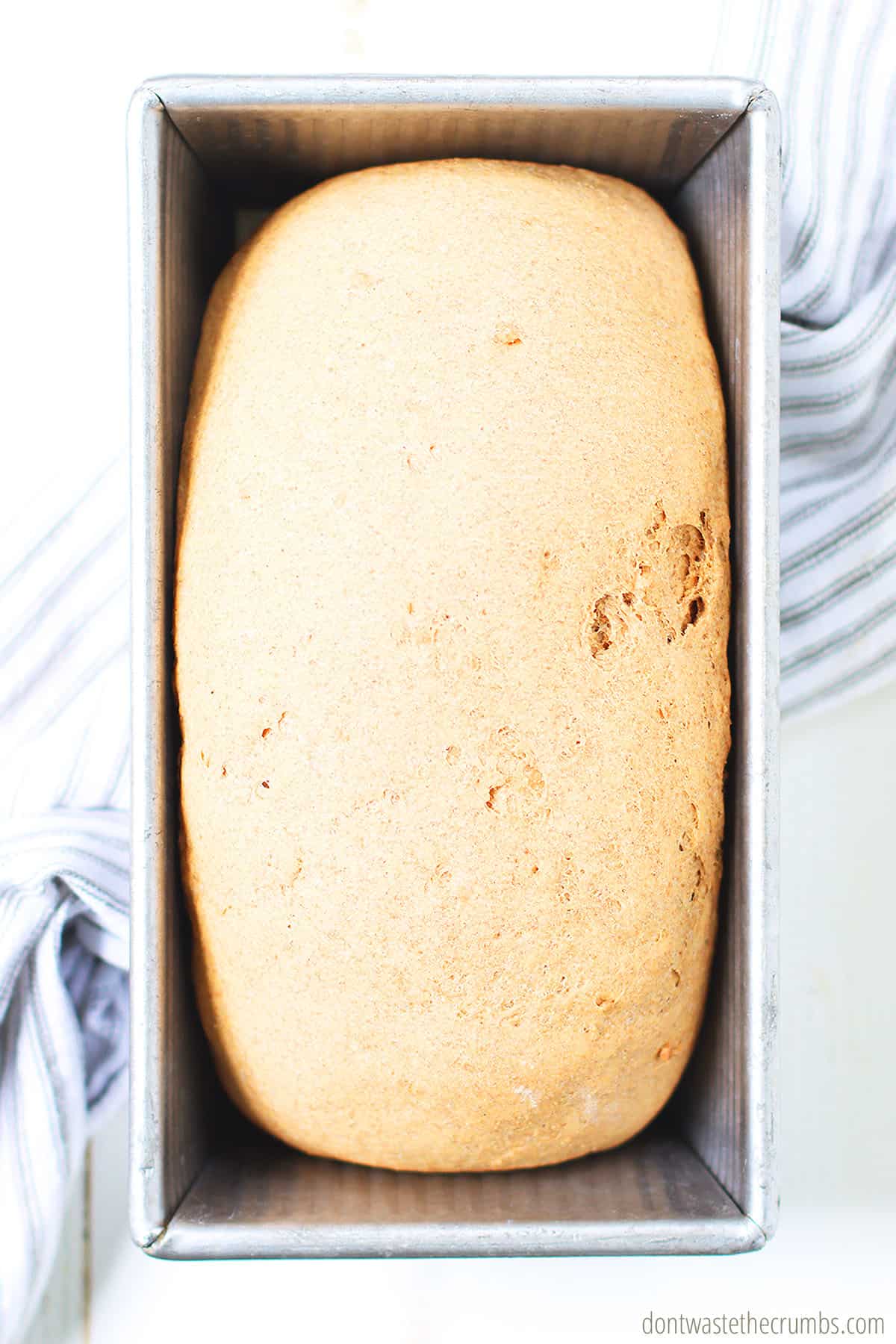
My Soaked Whole Wheat Bread Journey
Fortunately though, we’ve got a pretty good grip on our weekly routine since the new year. Every Thursday is soup night, and with that meal comes freshly baked bread. “Bake bread” shows up just once on my weekly planner and I make sure we’re home to do it. It’s really become that simple, and effective and getting the job done!
Our long-time favorite (and still a winner) is rosemary olive oil bread. We’ve tried it every which way you can possibly imagine and it’s always delicious.
- You’ll note that recipe is not prepared in a traditional manner. There’s no soaking, no freshly ground sprouted wheat.
- It’s a throw-it-in-the-bowl-and-have-bread-ready-in-a-few-hours-no-preparation-needed type of recipe.
- It worked for me because I didn’t want the “inconvenience” of the extra five minutes it took to soak my grains on Wednesday night.
Then, a close friend of ours got really sick earlier this year.
Since we would be helping out with meals on occasion, I used Dr. Google to find out what type of foods she should eat, shouldn’t eat, what to avoid, etc., so that we could help with her health and not just her meals.
The results weren’t too far from what’s recommended for a perfectly healthy person:
- eat lots of nutrient-dense foods
- avoid refined grains and sugar
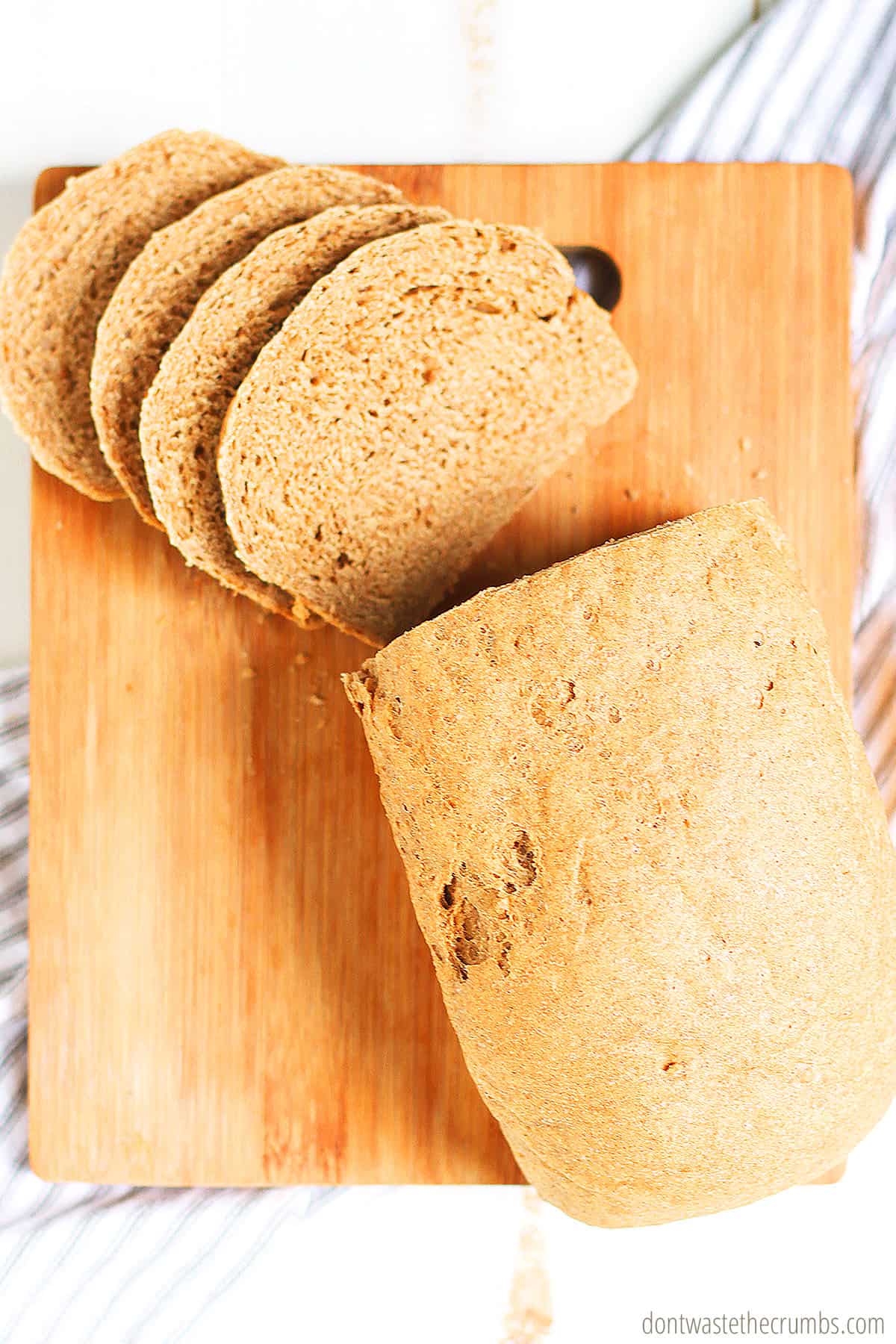
The first time we had them over for dinner, I soaked the whole grain flour overnight in an attempt to maximize every ounce of nutrition possible in her few slices of bread.
I kept this same routine for a couple of weeks – grinding grain and soaking on Wednesday afternoon, then making the bread on Thursday – and sharing small loaves with our friend.
After seeing how easy it really was, and remembering that I can’t turn a blind eye to inconvenience because I’m feeling lazy, “soak flour” has been added to my weekly planner every Wednesday.
Remember that I’m not a doctor and I am in no way saying that soaking your grains will prevent cancer. However, what I AM saying is that getting the most nutrition out of the food you eat isn’t a bad thing.
Searching for a good soaked bread recipe didn’t yield many results, so I turned back to my trusty Nourishing Traditions instead. Sally Fallon offers a recipe on page 493 called “Yeasted Buttermilk Bread” that seemed easy enough, and with just one cup of unbleached white flour (and four cups of whole grain flour), it met our goal of eating more whole grains too!
Here’s What You Need
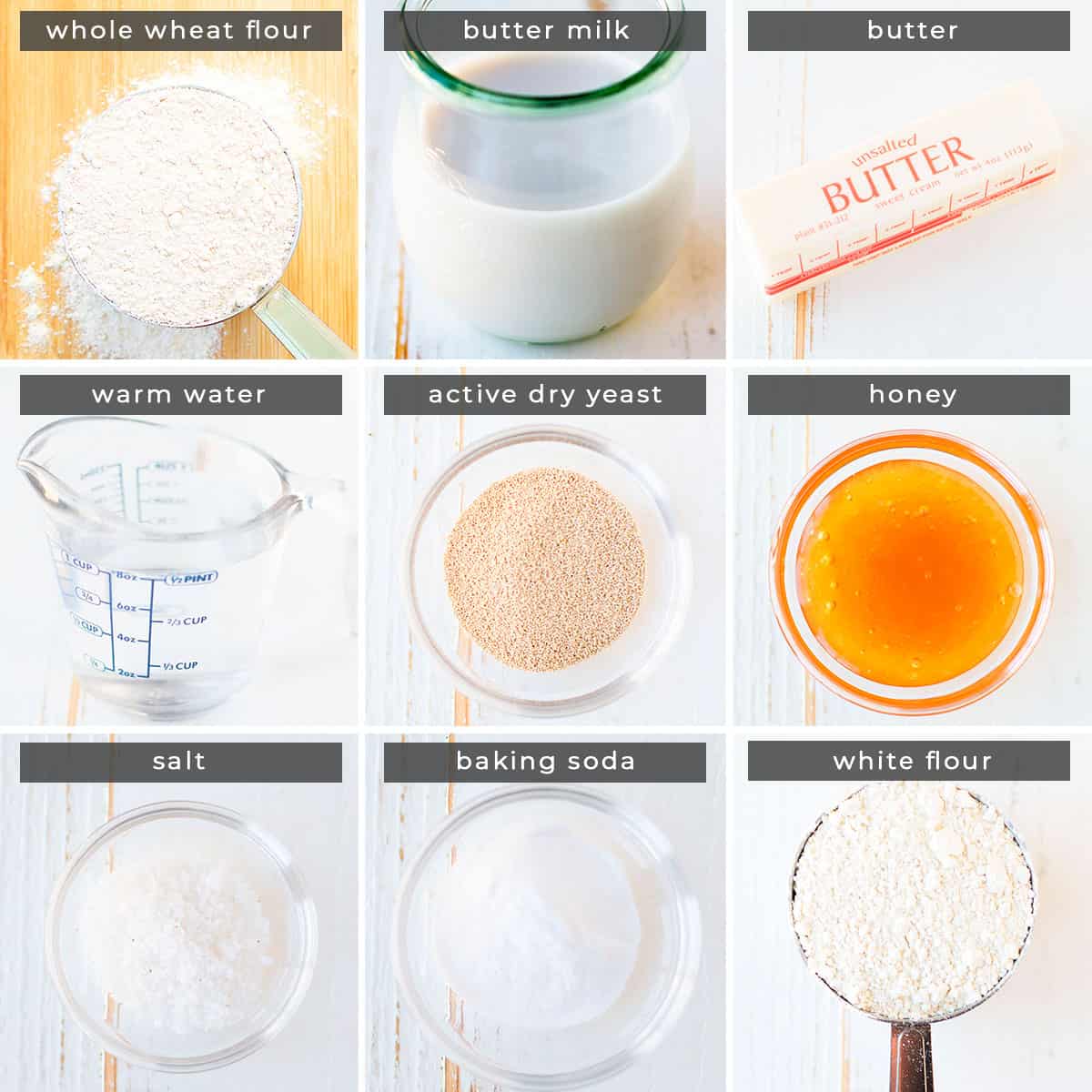
- whole wheat flour
- whey or buttermilk, or yogurt or kefir
- butter
- warm water
- active dry yeast
- honey
- salt
- baking soda
- unbleached white flour, plus more for dusting
- butter, for greasing loaf pans
Psst! If you’re going to add salt, I highly recommend Ava Jane’s Kitchen. You may think all salt is created equal, but unfortunately, 90% of the salt produced around the world contains microplastics (gross, right?). Ava Jane’s Kitchen is an exception. Their salt is 100% microplastic-free, and it’s SO GOOD! Plus, you can get a bag for just 1¢!! (Get your penny bag of salt on this page.)
How to Make This Soaked Whole Wheat Bread Recipe
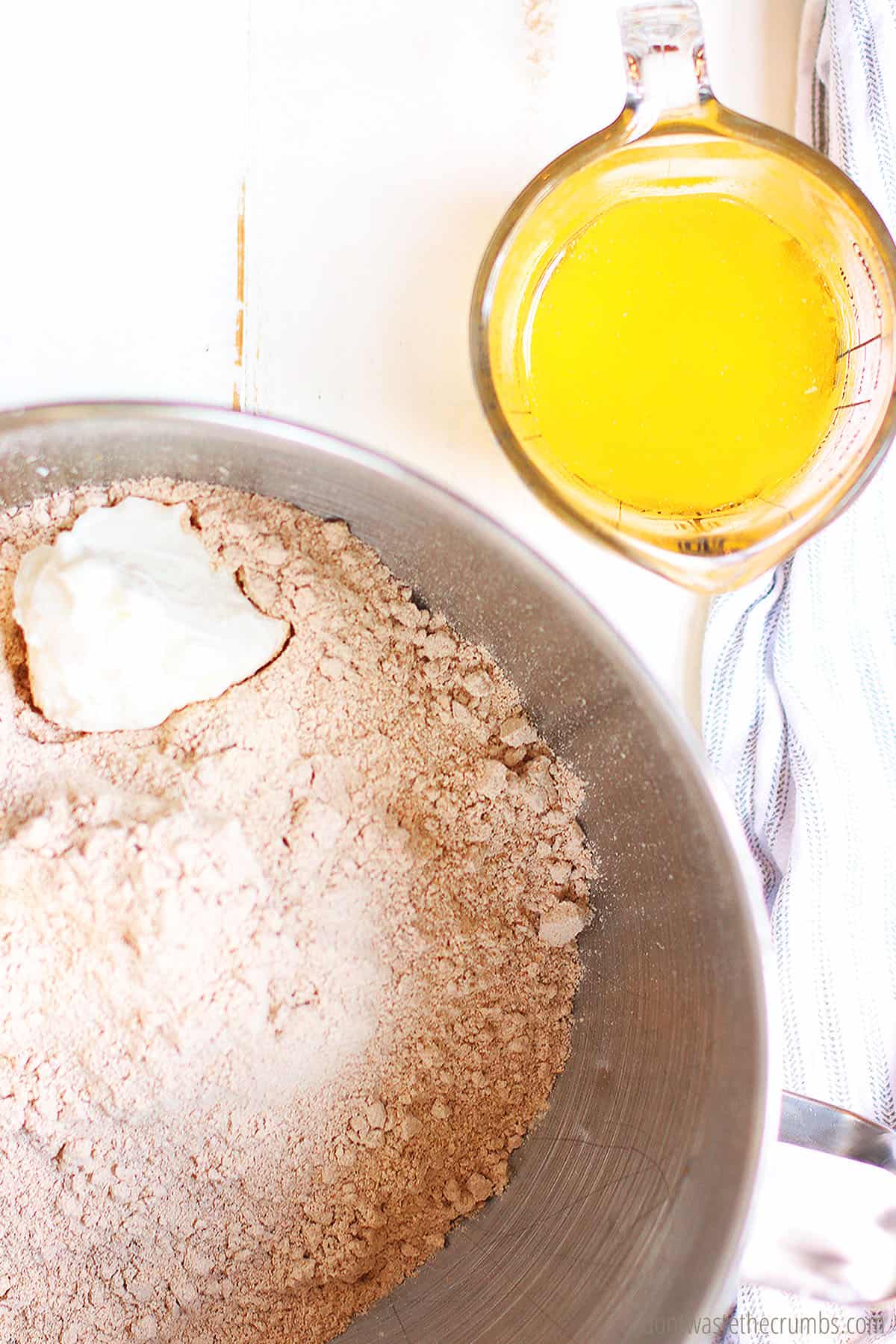
Step 1. In a large bowl, or in the bowl of a stand mixer, combine the whole wheat flour, whey/buttermilk/yogurt/kefir, and melted butter. Mix with a wooden spoon until a large ball of dough forms, or mix at medium-low speed for about 60 seconds. Add an additional liquid, one tablespoon at a time, if the dough seems overly dry. Knead to combine well.
Step 2. Cover with a towel and let it sit at room temperature for 12-24 hours, but at least overnight.
Step 3. When you’re ready to make bread, combine warm water, yeast, and honey in a small mug or measuring cup and allow the yeast to bloom for 5 minutes.
Step 4. Add the water/yeast/honey mixture to the soaked flour. Then, add the salt and baking soda to the soaked flour and knead by hand, or mix at medium-low speed, until the ingredients are well incorporated.
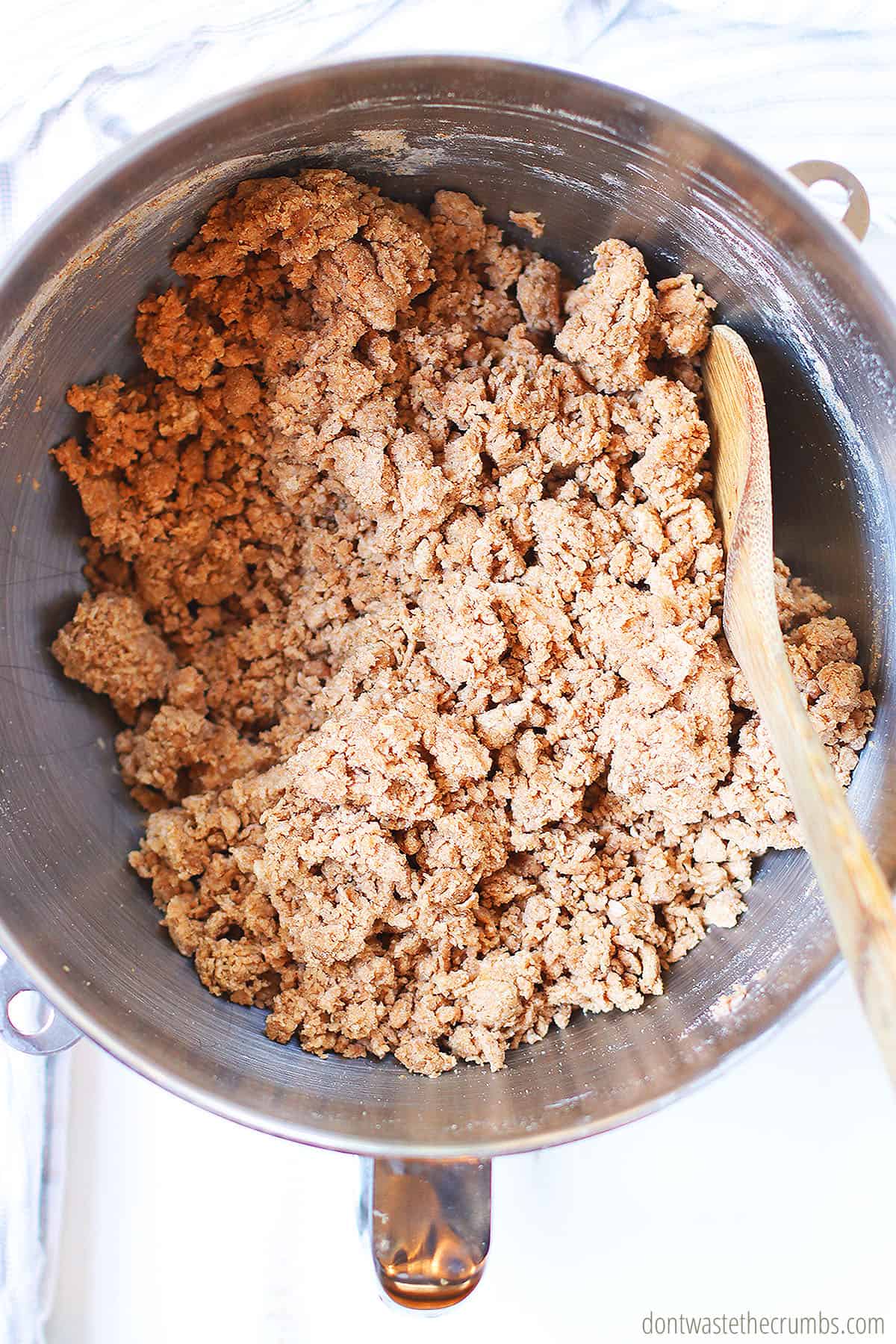
Step 5. Add 1 cup unbleached flour and knead by hand, or at medium speed, for a full 10 minutes. Add additional flour 1 Tbsp at a time if the dough is sticky past the 5-minute mark.
Step 6. Cover with a towel and let it rise for 2 hours, or until doubled in bulk.
Step 7. Dust your working surface and pour the dough on top. Punch down lightly and divide into two equal pieces.
Step 8. Working with one piece at a time, knead by hand for 30 seconds and shape into a rectangle. Starting at the short edge, roll the dough up tightly and place into a well-buttered loaf pan, using either a 9″x5″ pan, or an 8″x4″ pan, or one of each.
Step 9. Cover both loaves with a towel and let them rise for 1-2 hours, or until doubled in size.
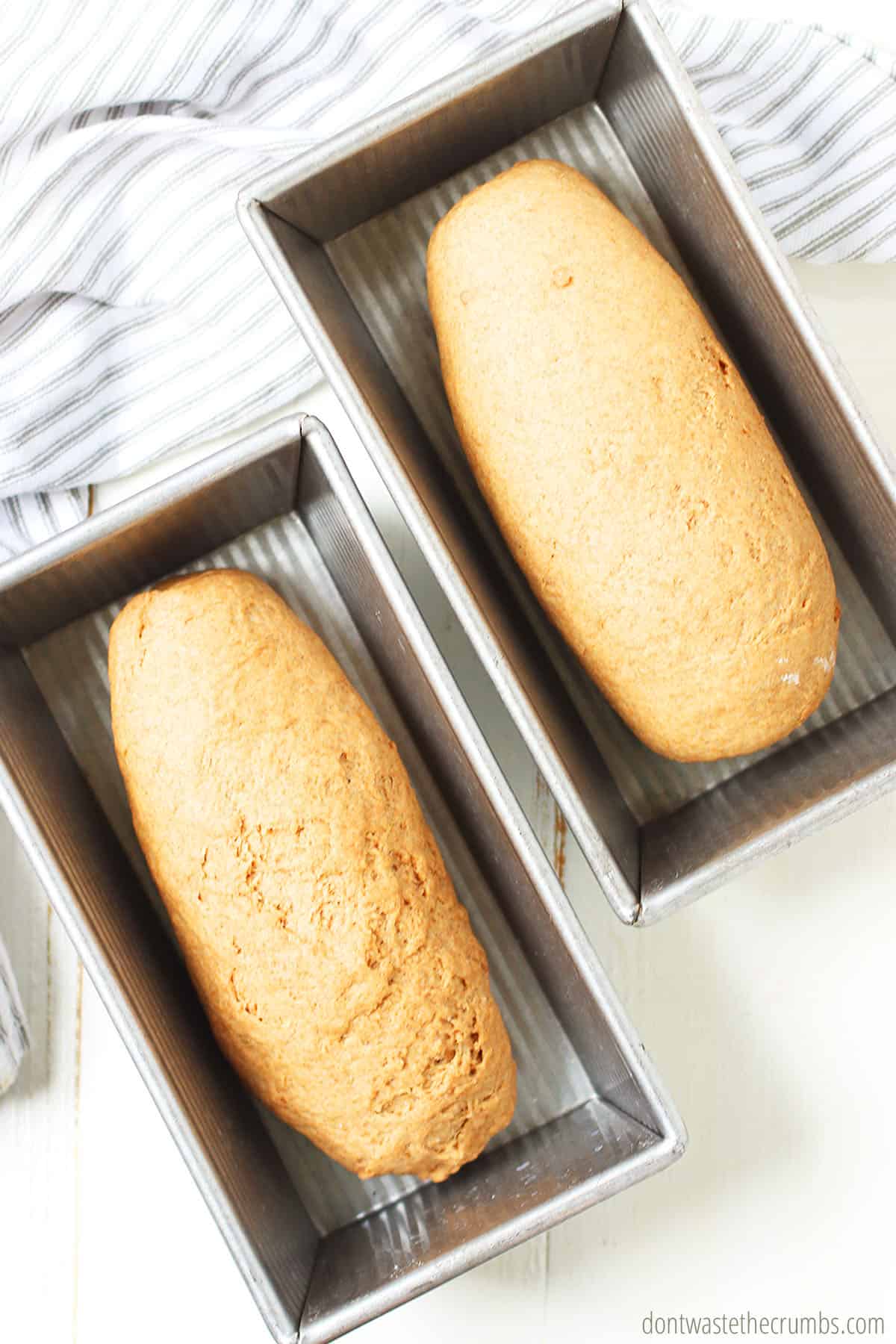
Step 10. Preheat oven to 350F and bake loaves for 25-30 minutes, until the outside is golden brown and the bottom sounds hollow when tapped. Allow cooling on a rack for at least 20 minutes before slicing.
Soaked Grain Bread FAQs
When you do an overnight soak it softens the grains. Doing so will break down some of their tough starches and give them time to absorb moisture. This makes the grains easy to work with the following day.
If you find yourself with a crumbly loaf, that means that there was not enough water or there was too much flour was used. Another reason this happened could be that the dough was not kneaded enough.
You can do a lot with soaked wheat! You can add it to baked goods, a granola bar recipe, casseroles, and even yogurt!
Conclusion
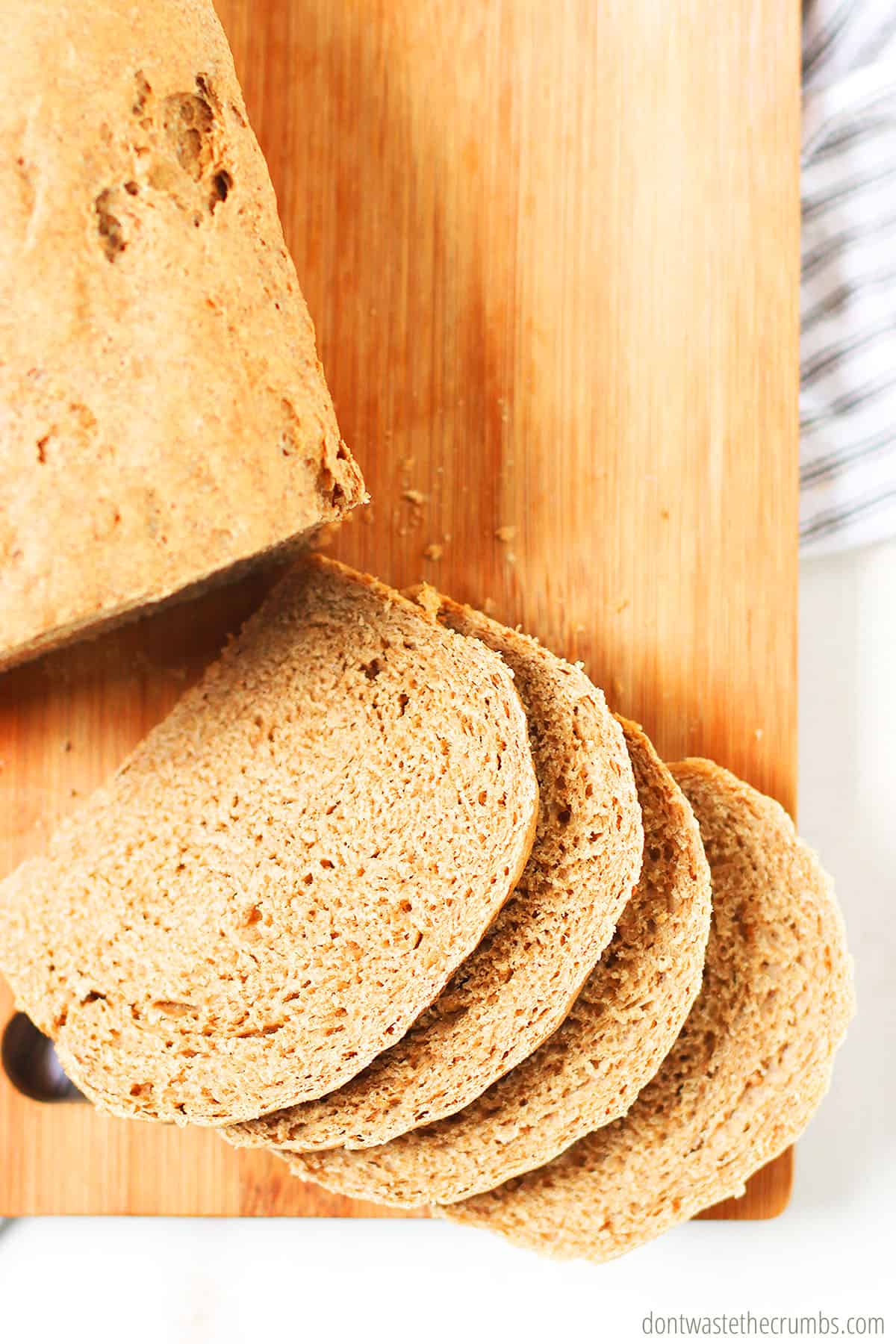
This recipe is my rendition of Ms. Fallon’s after many, many weeks of this bread being included on our weekly menu.
- I’ve tested it with whole wheat, spelt, oat, and even Kashi flour (which I don’t recommend, lol).
- I’ve subbed homemade yogurt, kefir, and whey for the buttermilk in the original recipe, after trying multiple variations of homemade buttermilk first of course.
- In the end, I’ve found my favorite combination, but this recipe adapts well to just about anything you throw its way. It’s perfect for soup night, holds up well to grilled sandwiches a couple of days later, and is lighter than most whole wheat bread recipes.
Of course, the pickiest eaters will notice the distinct taste of wheat, but see my additional tips after the recipe for a simple way to sneak this whole grain past them too!
More Soaked Whole Wheat Bread Recipe Tips
- My favorite combination of flour is 2 1/2 cups of freshly ground whole wheat and 1 1/2 cups of freshly ground spelt.
- Spelt is much lighter in flavor than wheat, tastes much like white flour and Mr. Crumbs has said numerous times that he prefers spelt over wheat. In fact, I’ve used spelt in place of the one cup of white flour and it’s come out just as delicious. Remember that you can grind your own flour without a mill with this tutorial if you don’t have one.
- My favorite soaking medium is whey, but 1/2 cup kefir and 1/2 cup milk are a close second place (mostly because they’re both almost always on-hand).
- We’ve tried this bread using granulated sugar in place of the honey, but I think the honey adds a hint of sweetness that really complements the whole grains. Use what you have!
- Don’t skip the butter and substitute at your own risk. 😉
More Homemade Bread Recipes
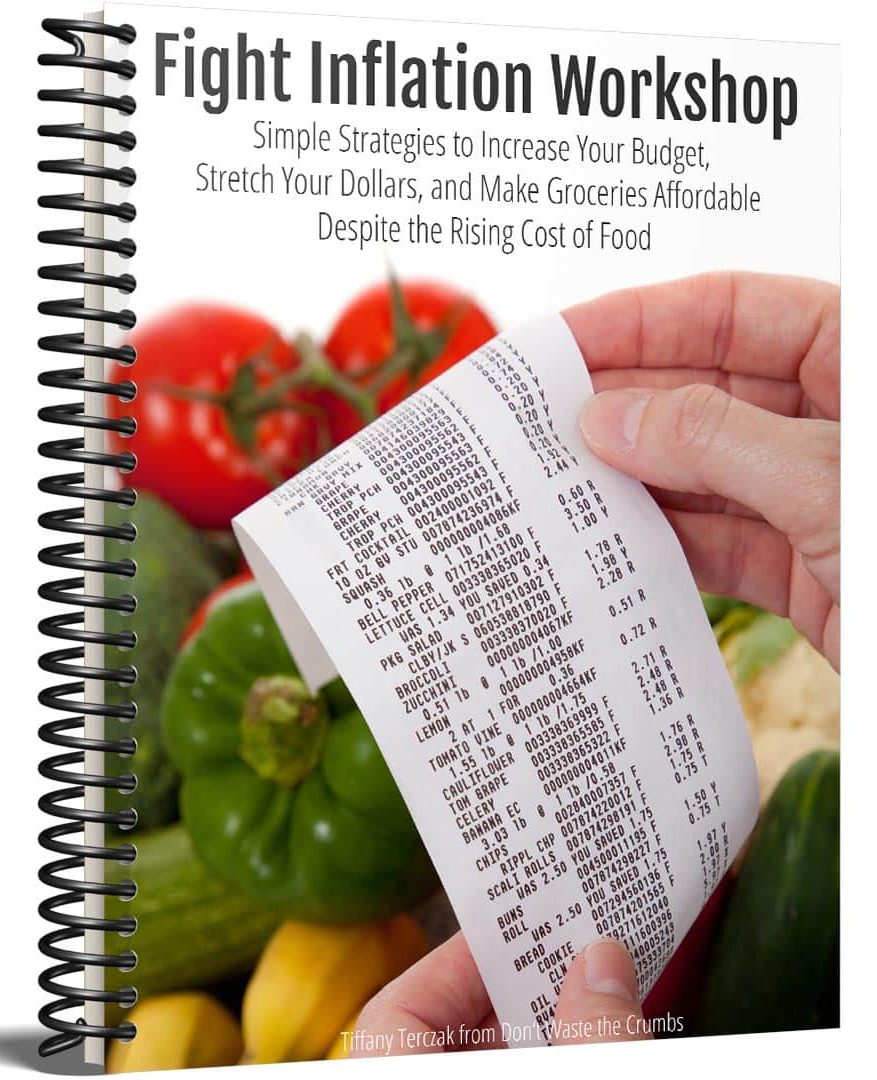
Fight Inflation Workshop
Sign up for my FREE Fight Inflation Workshop and learn simple strategies to save money, even with rising food costs!Easy & Delicious Soaked Whole Wheat Bread
A simple, easy, and delicious soaked whole wheat bread recipe that can be incorporated into any busy person’s routine to get the most nutrition out of bread. Be sure to try my overnight Artisan bread or my homemade French bread.
- Prep Time: 16 hours 20 minutes
- Cook Time: 30 minutes
- Total Time: 16 hours 50 minutes
- Yield: 2 loaves 1x
- Category: Breads
- Method: Oven
- Cuisine: American
Ingredients
- 4 cups whole wheat flour*
- 1 cup whey or buttermilk, OR 1/2 cup yogurt or kefir mixed with 1/2 cup whole milk, plus 2-4 Tbsp if needed
- 1/2 cup butter, melted
- 1/4 cup warm water (105F-110F)
- 2 1/4 tsp active dry yeast
- 2 Tbsp honey
- 1 tsp salt
- 1/2 tsp baking soda
- 1 cup unbleached white flour, plus more for dusting
- butter, for greasing loaf pans
Instructions
- In a large bowl, or in the bowl of a stand mixer, combine the whole wheat flour, whey/buttermilk/yogurt/kefir, and melted butter. Mix with a wooden spoon until a large ball of dough forms, or mix at medium-low speed for about 60 seconds. Add an additional liquid, one tablespoon at a time, if the dough seems overly dry. Knead to combine well.
- Cover with a towel and let it sit at room temperature 12-24 hours, but at least overnight.
- When you’re ready to make bread, combine warm water, yeast, and honey in a small mug or measuring cup and allow the yeast to bloom for 5 minutes.
- Add the water/yeast/honey mixture to the soaked flour.
- Add the salt and baking soda to the soaked flour and knead by hand, or mix at medium-low speed, until the ingredients are well incorporated.
- Add 1 cup unbleached flour and knead by hand, or at medium speed, for a full 10 minutes. Add additional flour 1 Tbsp at a time if the dough is sticky past the 5 minute mark.
- Cover with a towel and let it rise for 2 hours, or until doubled in bulk.
- Dust your working surface and pour dough on top. Punch down lightly and divide into two equal pieces.
- Working with one piece at a time, knead by hand for 30 seconds and shape into a rectangle.
- Starting at the short edge, roll the dough up tightly and place into a well-buttered loaf pan, using either a 9″x5″ pan, or an 8″x4″ pan, or one of each.
- Cover both loaves with a towel and let them rise for 1-2 hours, or until doubled in size.
- Preheat oven to 350F.
- Bake loaves for 25-30 minutes, until the outside is golden brown and the bottom sounds hollow when tapped.
- Allow to cool on a rack for at least 20 minutes before slicing.
Notes
* You can substitute up to half of the whole wheat flour with another whole grain, such as spelt or kamut. However, it is best to use at least 2 cups of whole wheat flour.
Nutrition
- Calories: 635

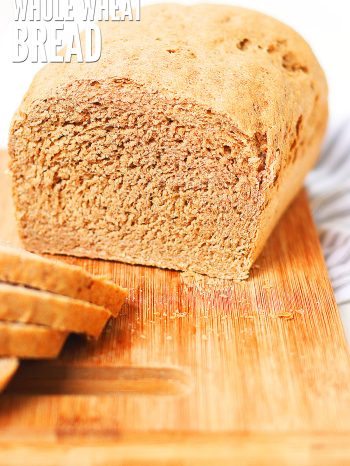


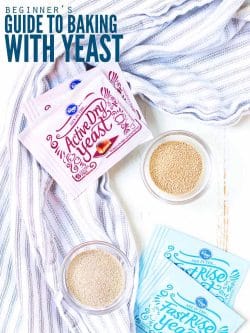
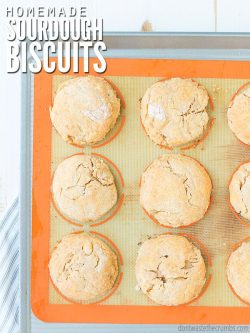

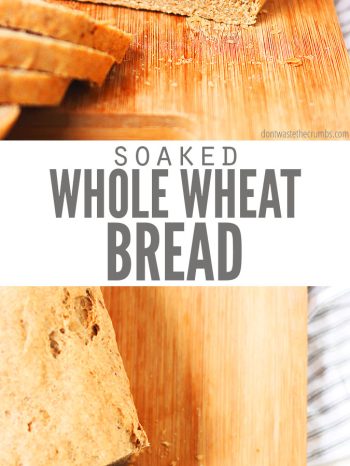
I absolutely loved this bread, as did my friend I shared a loaf with . My only complaint is that the loaves were pretty small, but I suppose I could make one bigger loaf and a smaller loaf. The recipe is truly easy and delicious! Thank you!
Hi Tiffany! Do you think this could be made GF? I found a whole grain GF flour blend from America’s Test Kitchen that uses teff flour, brown rice flour, and sweet rice flour, and it worked great in a soaked muffin recipe. I think I could use that blend in lieu of whole wheat flour here but I’m not sure what I’d sub for the unbleached white flour. Thoughts?
Hi Bethany! Most bread recipes cannot sub 1:1 with GF flours. They will not rise with the lack of gluten. You’ll be better off looking for a GF bread recipe that will have additional ingredients to help create the fluffiness found in wheat breads. I hope that helps!
I made the bread over the last two days. I think the liquid amount is off. I ended up adding a extra 1/4 cup of buttermilk to the soaking. I used a ratio of 75/25 wheat flour to spelt. When I added the yeast/ water mixture I had to add two tablespoons of milk and I never got to add the 1 cup AP flour. It came out fine, toast good. Good breakfast loaf. I only gave it 3 stars because it takes someone with bread making experience to handle this recipe. It would also be helpful if we had the weight. I don’t know if my flour was enough different. I will try looking at the original recipe to see if I can figure it out. I like the recipe.
I was reading the other day about making bread with wheat flour or using it with another flour. You need to add more liquid because wheat flour takes more liquid than other flour. Did you try freezing any of the loaves?
Made some cheese and had left over whey liquid, so I was thrilled to find this recipe! This bread is so good, and so easy to throw together if you have a little time. One question though: I noticed the bread isn’t coming out “tear-able” like other breads I’ve made. Should I knead it more to develop more gluten and create a more open grain?
Hi Sarah,
Can you clarify on “tear-able”? Does you mean the crumb, or the texture of the bread itself? Can you give a more tangible example, like are you expecting to be softer when you take a bite of a sandwich? Want to make sure I’m on the same page.:)
This is our favorite! Thank you!
Have you ever used Einkorn flour as the whole wheat in your Soaked Whole Wheat bread? If yes, are there any fluid amount or flour amount modifications that need to be made?
Thank you.
Hi Penny! I haven’t, but anytime you use einkorn you’ll want to reduce the liquid by 25% OR increase the flour by 25%. I usually decrease the liquid (b/c it’s cheaper) and then add additional flour, by feel, if needed.
Whoops-accidentally left my review as a comment to another comment!
This was lovely! I ended up adding quite a lot of extra liquid during the initial mixing-slightly more than half a cup extra! But I loved the end result! My father complained that it wasn’t very flavorful, but I think that was just him being ornery, because the rest of my family loved it! I was surprised by the presence of the baking soda, but I added it anyway. I think next time I will increase the salt a little bit. I subbed in EVOO for half of the melted butter, and I loved it!
So, this recipe says it calls for a whole wheat and white flour mixture, and in one of your comments you said you like to replace some of the whole wheat flour with spelt. But what about einkorn? And if you mill your own fresh flour, will it still benefit from soaking? I want to send this recipe (and knowledge of your site in general) to my vegan sister. I saw that you can replace the dairy with ACV (1 tablespoon per cup of liquid), but what about the butter? Could you use coconut oil? Thanks so much for sharing this recipe, and I love your website!
Hi Ellie! You can use coconut oil in lieu of butter. We’ve done that with our “Man Bread” recipe and it’s delicious! You can also replace some of the whole wheat flour with einkorn. Einkorn is slow to rise and slow to absorb water, so you can treat it like you would spelt or another non-hard red wheat grain. Yes, you can still benefit from soaking even if you mill your own flour!!
Have you ever tried substituting the butter with anything else or tried ghee butter? I fermented my bread and realized I forgot to pick up butter at the store last night :(, new mom brain 🤪 I’ve made this recipe a few times now and love it!!
Thanks!!
I’ve been looking for a recipe that seems promising, and this is the one! Do you know how I could adapt it if I skipped the sprouting process? I don’t currently include the sprouting ingredients in my budget.
Do you mean skip the soaking Abigail? This recipe is written specifically for soaking, but we have several others that don’t need to be soaked! Here’s a list of all my bread posts: https://dontwastethecrumbs.com/category/recipes/breads2/
I have recently begun soaking our grains before making bread. My question is regarding a whole wheat sourdough recipe. Is it necessary to soak the grains in that case since you’re already working with a fermented starter? If it would provide additional benefits, how do you go about it without having a mushy mess instead of dough?
What does soaking flour mean?
Can you soak sprouted wheat flour for this recipe?
You can, but you won’t get any additional health benefits because your flour is already alive!
I have a question. Why do you use baking soda in your recipe? Can your friend handle it without it?